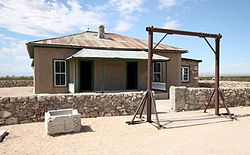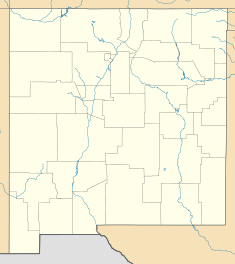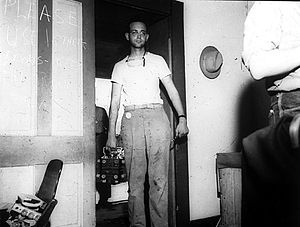- McDonald Ranch House
-
McDonald Ranch House
 The McDonald-Schmidt Ranch House after restoration.Location of McDonald Ranch House in New Mexico.
The McDonald-Schmidt Ranch House after restoration.Location of McDonald Ranch House in New Mexico.Location: White Sands Missile Range Nearest city: San Antonio, New Mexico Coordinates: 33°39′2.66″N 106°27′37.28″W / 33.6507389°N 106.4603556°WCoordinates: 33°39′2.66″N 106°27′37.28″W / 33.6507389°N 106.4603556°W Built: 1913 Part of: Trinity Site (#66000493) The McDonald Ranch House was the location of assembly for the first tested nuclear weapon. The test occurred on July 16, 1945; a plutonium bomb was tested, the type of weapon later dropped on Nagasaki, Japan. The weapon used against Hiroshima was a uranium bomb, a type not tested prior to its use in World War II, because it had a simpler design.
The "gadget" was assembled there, the components having arrived on July 12. It was assembled on the next day, and winched up the Trinity test tower the following day.
The George McDonald Ranch House sits within an 85' x 85' low stone wall. The house was built in 1913 by Franz Schmidt, a German immigrant, and an addition was constructed on the north side in the 1930s by the McDonalds. There is a display on the Schmidt family in the house during each open house.
The ranch house is a one-story, 1,750-square-foot (163 m2) building. It is built of adobe, which was plastered and painted. An ice house is located on the west side, along with an underground cistern which stored rain water running off the roof. At one time, the north addition contained a toilet and bathtub, which drained into a septic tank northwest of the house.
There is a large, divided water storage tank and a Chicago Aermotor windmill east of the house. The scientists and support people used the north tank as a swimming pool during the long hot summer of 1945. South of the windmill are the remains of a bunkhouse and a barn which was part garage. Further to the east are corrals and holding pens. The buildings and fixtures east of the house have been stabilized to prevent further deterioration.
The ranch was evacuated under protest in 1942, when the Alamogordo Bombing and Gunnery Range took over the land to use in training World War II bombing crews. The house stood empty until the Manhattan Project support personnel arrived in early 1945.
Inside the house, the northeast room (the master bedroom) was designated the assembly room. Workbenches and tables were installed. To keep dust and sand out of instruments and tools, the windows were covered with plastic. Tape was used to fasten the edges of the plastic and to seal doors and cracks in the walls.
The explosion, only two miles away, did not significantly damage the house. Most of the windows were blown out, but the main structure was intact. Years of rain water dripping through holes in the roof did much more damage. The barn did not do as well. During the Trinity test, the roof was bowed inward and some of the roofing was blown away. The roof has since collapsed.
The house stood empty and deteriorating until 1982, when the U.S. Army stabilized the house to prevent any further damage. Shortly after, the Department of Energy and U.S. Army provided the funds for the National Park Service to completely restore the house. The work was completed in 1984. All efforts were directed at making the house appear as it did on July 12, 1945.
External links
Categories:- Historic district contributing properties
- Manhattan Project
- Nuclear weapons program of the United States
- White Sands Missile Range
Wikimedia Foundation. 2010.


